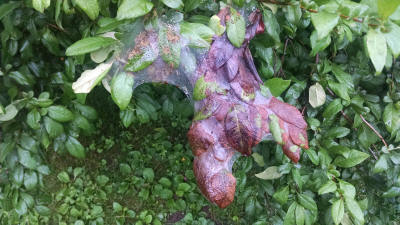|
 Column Column
Soldier Beetles, Fall Webworms, and To
Do List
By John Fulton
 Send a link to a friend
Send a link to a friend
[June 18, 2015]
Soldier Beetles - As linden
trees are shedding pollen, that means the leatherwing beetles – or
soldier beetles are with us. They look like pale lightning bugs, but
don’t have the light. These beetles are elongate, soft-bodied and
about 1/2 inch long. Colors of soldier beetles vary from yellow to
red with brown or black wings or trim.
|
|
 A common and easily-spotted species is the Pennsylvania
leatherwing, which is yellow with one large black spot on each
wing. Most larvae are carnivorous, feeding on insects in the
soil. Larvae overwinter in damp soil and debris or loose bark.
The adults are also predators, eating caterpillars, eggs,
aphids, and other soft-bodied insects. They will alternatively
eat nectar and pollen if no insects are around. They do not
damage plant foliage. Adults are often found on flowers such as
goldenrod, where they lie in wait for prey, feed on pollen and
mate. Since soldier beetles are beneficial, it is inadvisable to
kill them. A common and easily-spotted species is the Pennsylvania
leatherwing, which is yellow with one large black spot on each
wing. Most larvae are carnivorous, feeding on insects in the
soil. Larvae overwinter in damp soil and debris or loose bark.
The adults are also predators, eating caterpillars, eggs,
aphids, and other soft-bodied insects. They will alternatively
eat nectar and pollen if no insects are around. They do not
damage plant foliage. Adults are often found on flowers such as
goldenrod, where they lie in wait for prey, feed on pollen and
mate. Since soldier beetles are beneficial, it is inadvisable to
kill them.

Fall Webworms
This is one of those years where it looks like we will have two
generations of the fall webworm. Fall webworms live inside a
“web” all the time. They actually expand the webbing as they
need to have more leaves to eat. They are usually worst on fruit
and nut trees. You can even clip the nest (and the branch it is
around) off the tree and burn it. I guess this tells you that
defoliation caused by the insect is a threat to
the tree or you wouldn’t cut the branch area off. If you want to
spray fall webworms, you need to get the spray through the web.
This may be a little harder than you think. If you don’t have
enough pressure, the spray just runs off the webbing.
When we talk about controls of the larvae, the fact that they
are larvae of moths or butterflies makes them susceptible to the
use of B.t. products such as Thuricide. Other control options
include the standbys such as Sevin, Othene, malathion, and the
synthetic pyrethroids such as bifenthrin and permethrin among
others.
[to top of second column] |

To Do List
There are always many thing to do, and this year just keeping up
with mowing chores is one of the major ones. Try to remove no
more than a third of the leaf blade at a time, meaning a two
inch mowing height should lead to mowing when grass is three
inches tall. Of course you can’t mow that often at times. If
grass material begins to build up, raking will probably be
needed. Bagging is also an option if your equipment allows this
option.
Work away on pruning those evergreens, including the broadleaf
evergreens such as holly or azalea. The idea is to prune
evergreens in late June to keep from having rank growth on one
extreme and new tender growth which might winterkill on the
other. Remember, pruning is a rejuvenation process. This means
new growth will be spurred on by your pruning.

We’ve actually begun the fall gardening season this week. It’s
time to plant Brussels sprouts, collards, kale, kohlrabi,
peppers, potatoes, summer squash, and tomatoes for fall harvest.
You can also do some successive plantings of things like green
beans, sweet corn, cucumbers, and beets. That is, when it is dry
enough to work in the garden.
[By JOHN FULTON, COUNTY EXTENSION
DIRECTOR SERVING LOGAN, MENARD, AND SANGAMON COUNTIES] |